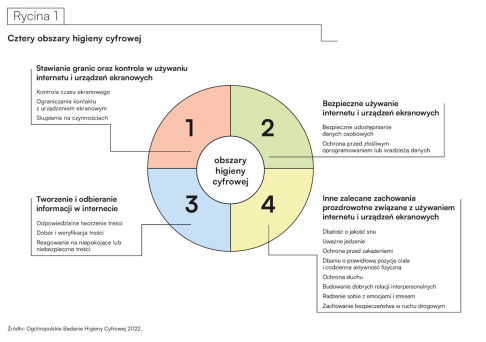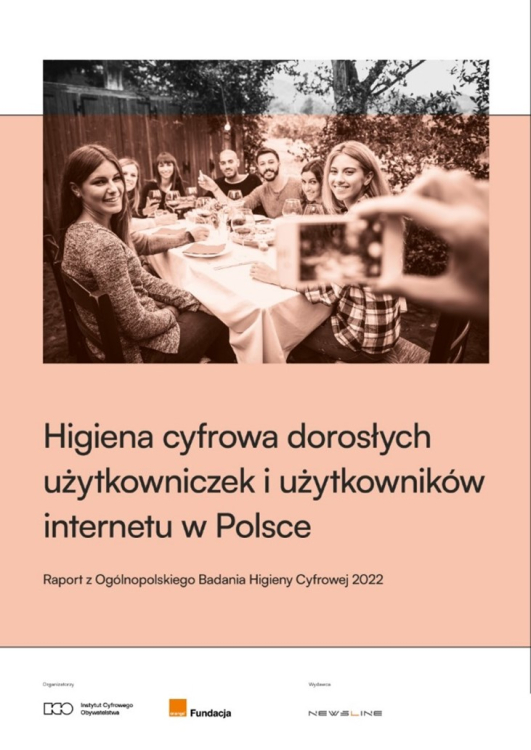Do adult Internet users in Poland care about digital hygiene?

A report has recently been developed on digital hygiene among Polish Internet users. It was compiled on the basis of the findings gathered during the Nationwide Digital Hygiene Study in Poland 20221.
The study was conducted by the Digital Citizenship Institute Foundation and the Orange Foundation. The Faculty of Health Sciences at the Medical University of Warsaw (WUM) was the honorary sponsor of the research project. Together with Magdalena Bigaj, President of the Digital Citizenship Institute, Magdalena Woynarowska, PhD in Social Sciences, from the Public Health Institute co-authored the study and the research tool, whereas Mariusz Panczyk, PhD in Medical Sciences and Health Sciences, from the Department of Education and Research in Health Sciences, participated in the work on the report and the analysis of the study findings.
What makes digital hygiene important
With the widespread availability of screen displays and the Internet, their attractiveness and daily functionality have triggered major changes in people’s lifestyles. People have been spending more and more time using these devices, particularly in a sedentary position. Within a short time, people transferred a major part of their everyday activity to the digital world where a lot of business can be dealt with faster, where you can access a huge volume of information, communicate with others and build relationships over distance, spending time on entertainment.
These changes were further reinforced by the COVID-19 pandemic during which the time spent with screen devices extended for many people, these devices became work/study tools wherever possible, and they were used for communication at an unprecedented scale. The advancement of information and communication technologies is going to proceed rapidly, and screen devices will have a continuously stronger presence in people’s lives.
Use of screen devices and the Internet is linked to other human behaviors, affecting people’s functioning, well-being and health. Whether these effects are positive or negative depends on multiple factors, such as how long, why, how and when people use these devices, the emotions they experience at the time, other actions they undertake simultaneously, and those which are given up. Using these devices excessively, without full awareness, involves certain threats to physical, mental and social life. It may lead to reduced physical activity, musculoskeletal ailments, sleep disorders, fatigue, vision and hearing problems, deteriorated mental well-being, problems with vision and hearing, lower mental well-being, problems with focus/concentration, weakening of social bonds, accidents and injuries. People have to be aware of these risks and learn what to do to protect their health.
What is digital hygiene
According to M. Bigaj and M. Woynarowska, digital hygiene consists of health protecting behaviors related to the use of information and communication technologies, particularly screen devices and the Internet. There are many behaviors in this category, relating to different aspects. For this reason, digital hygiene has been considered a complex construct and the researchers attempted at systematizing the behaviors in which digital hygiene manifests itself. Four areas of these behaviors have been distinguished (Fig. 1).

Nationwide Digital Hygiene Study in Poland 2022
The cross-sectional study was conducted in November 2022 on a representative group of 1067 adult Internet users of both genders in Poland. The population sample represented the social and demographic structure of the general population of Poland in terms of age, gender, place of residence, region/voivodeship and level of education.
The diagnostic survey was used, involving Computer-Assisted Web Interviewing (CAWI). The research tool was the Digital Hygiene Self-Assessment Questionnaire developed by M. Bigaj and M. Woynarowska, taking into account the opinions of experts and Internet users. Its use in the proper study was preceded by conceptualization and operationalization of the concept of “digital hygiene” as well as a pilot phase.
Findings
The study findings indicate that the majority (64.4%) of the surveyed adult Internet users believe they spend a lot of time using screen devices: 38.5% claim they spend quite a lot of time in this way, while 25.9% state that it is too much time. This may be a sign of awareness of their ‘screen immersion’. However, at the same time too many participants follow the rules of digital hygiene at a recommended frequency which is good for their health, i.e. “always or almost every time”2. Only 9 out of 39 health protecting behaviors related to the use of screen devices are undertaken with the advisable frequency by approximately half of the participants or more (from 49.8% to 67.0%). For as many as 21 behaviors, this frequency is attained by 25.0% of the survey participants or less. These are mainly Area 1 (Setting limits and control in using the Internet and screen devices) and Area 4 (Other recommended health promoting behaviors for using the Internet and screen devices) activities.
Selected findings of the study including the desirable answer “always or almost every time”:
- 14.3% of the participants monitor their screen time, 21.9% limit notifications on their phone/computer, and 20.3% remove their phones from the range of vision when doing something that requires focus,
- 9.3% of the participants avoid using screen devices before going to sleep, and 18.1% try not to put their phones next to or in their beds before going to sleep,
- 20,1% of the participants avoid snacking while using screen devices, and 25.2% eat their meals without their phones in sight,
- 9.9% of the participants clean/disinfect their phones at least once a day,
- 12.1% to 22.8% of the respondents engage in activities promoting good body position and daily physical effort when using screen devices.
Digital hygiene deficiencies may have an adverse effect on the personal and professional functioning of adults, their well-being and health. Adults who do not follow digital hygiene principles are not good role models for children and adolescents in this area. Therefore, educational measures to promote digital hygiene among adults are urgently needed.
Today, digital hygiene is a desirable new component of a healthy lifestyle. People should be taught that misusing of screen devices and the Internet may become a ‘new’ risk factor for their health, at present and in the future, and they should be educated in the area of digital hygiene by presenting the right behaviors, the reasons for behaving in a particular way, the possible advantages of such behaviors for themselves and their environment, particularly children and adolescents. They should be encouraged to apply digital hygiene principles in their everyday lives, because you not only have to endorse them but also put them into practice if you want them to work. Such education should become a new important area of health education taking place at various locations: at home, at schools, workplaces, in the media.
Digital Hygiene Test
The Digital Hygiene Self-Assessment Questionnaire, also called the Digital Hygiene Test, is available free of charge at cyfroweobywatelstwo.pl It is there to use for anyone who may be interested. The test contains statements describing specific positive, desirable health promoting behaviors related to the use of screen devices and the Internet. It gives the study participants an opportunity to assess their own behaviors in the area of digital hygiene, as well as new or enhanced knowledge of the subject matter. The test is simple and does not take much time to complete.
The test may be useful for:
- People interested in their own digital hygiene and improvement in this area. Self-diagnosis of one’s own digital hygiene behaviors may be an opportunity for reflection, self-awareness, a starting point for introducing health promotion changes in one’s own habits.
- Persons involved in education in the field of digital hygiene, whether on a formal or informal basis. Digital hygiene self-assessment can be used to diagnose the behaviors of persons being the target of educational measures, or as a starting point to search for ways to improve these behaviors so as to promote health. Self-assessment results can be used in planning and evaluation of educational measures.
Limitations to the research project
The research project is representative for the adult population of Poland who use screen devices with Internet access. Persons who do not use screen devices were intentionally excluded from the project because the behaviors involved in the use of such devices are not relevant. The categories of answers used in the Digital Hygiene Test (“always or almost every time”, “often”, “sometimes”, “never or hardly ever”) are subjective and therefore the research findings should be considered as an estimation.
The Digital Citizenship Institute together with the researchers from the WUM Faculty of Health Sciences will proceed with further research work on the development of the Digital Hygiene Self-Assessment Questionnaire as a measurement tool, specifically on the evaluation of its accuracy (in terms of content and criteria), stability (test-retest assessment) and unidimensionality of subscales (measures).

The report with the research findings and recommendations, as well as the research tool entitled Digital Hygiene Test, are available at cyfroweobywatelstwo.pl
Footnotes:
1 Bigaj, M. (red.), Woynarowska, M. (red.), Ciesiołkiewicz, K., Klimowicz, M., Panczyk, M. (2023). Higiena cyfrowa dorosłych użytkowniczek i użytkowników internetu w Polsce [Digital Hygiene Among Adult Internet Users in Poland]. Warszawa: Wydawnictwo Newsline → www.higienacyfrowa.pl
Authors of the study and the research tool: M. Bigaj (Digital Citizenship Institute), M. Woynarowska (Department of Public Health, WUM Medical University of Warsaw).
2 The answers “often” and, specifically, “sometimes” and “never or hardly ever” were considered to imply that these behaviors are not frequent enough, which may have a negative effect on health.
Editors: Communication and Promotion Office of the University
Photo: Michał Teperek; Communication and Promotion Office, WUM University